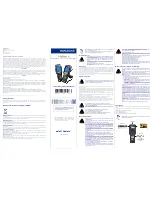
In the
Window 4
, select “Record Define”. With your mouse
right
-click on the white area
below and select “Add”. Select
Value Type
as “Reference Value” and
Value
as “Screen
Define1->Text Define1” and click OK. Do this a second time (right click, select “Add”)
but this time set your
Value
to “Screen Define1->Text Define2”.
*Note:
Careful not to select “Screen Define1->
Label Define2
” (or Label Define1)
The text labels, text input, and file information has been defined. The last step is to set
the flow. The flow chart below will illustrate the final task:
Screen Define 1
Æ
Label Define 1
Æ
Label Define 2
Æ
Text Define 1
Æ
Text Define 2
Æ
Save Define 1
Æ
Screen Define 1.
It is important to note that after “Save Define1” the flow goes back to “Screen Define 1”
which is where the flow originally started.
In
Window 1,
click on “Demo (Demo.ejd)” and then select the “Property” tab from
Window 4
. Set the
Startup
to “Screen Define1”
In
Window 2
, click on “Screen Define 1” and then select the “Information” tab from
Window 4.
Set
Goto
to “Screen Define->Label Define1”.
In
Window 2
, click on “Label Define 1” and then select the “Property” tab from
Window 4.
Set
Goto
to “Screen Define->Label Define2”.
In
Window 2
, click on “Label Define 2” and then select the “Property” tab from
Window 4
. Set
Goto
to “Screen Define->Text Define1”.
In
Window 2
, click on “Text Define1” and then select the “Default Next Action” tab
from
Window 4
. Set
Default Goto
to “Screen Define->Text Define2”.
In
Window 2
, click on “Text Define2” and then select the “Default Next Action” tab
from
Window 4
. Set
Default Goto
to “Screen Define->Save Define1”.
In
Window 2
, click on “Save Define1” and then select the “Next Action” tab from
Window 4.
Set the
Save Success Goto
to “Screen Define 1”. Set the
Save Fail Goto
to
“Screen Define1”. We will not create a fail-screen in this demo.
The application is complete!
6

















